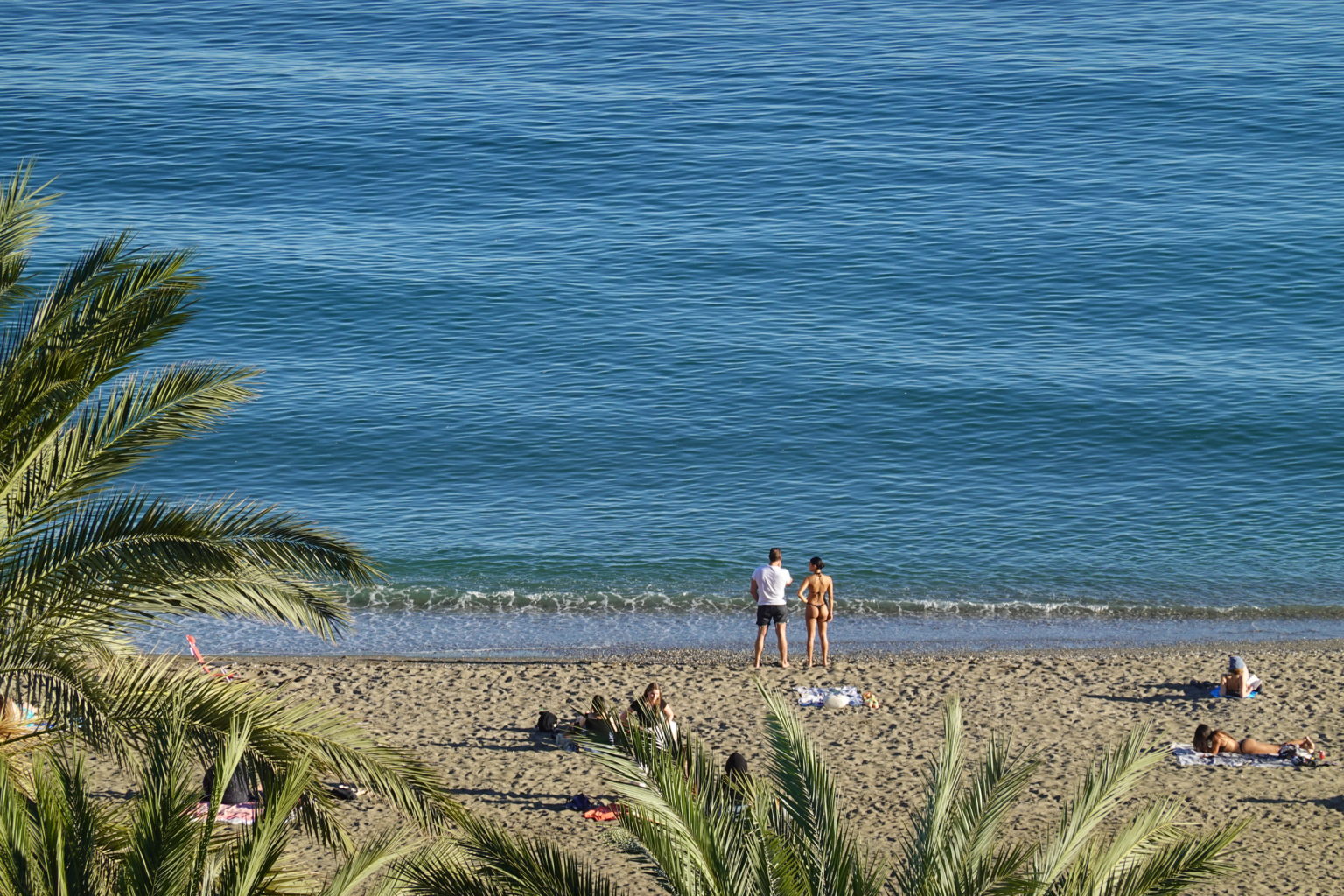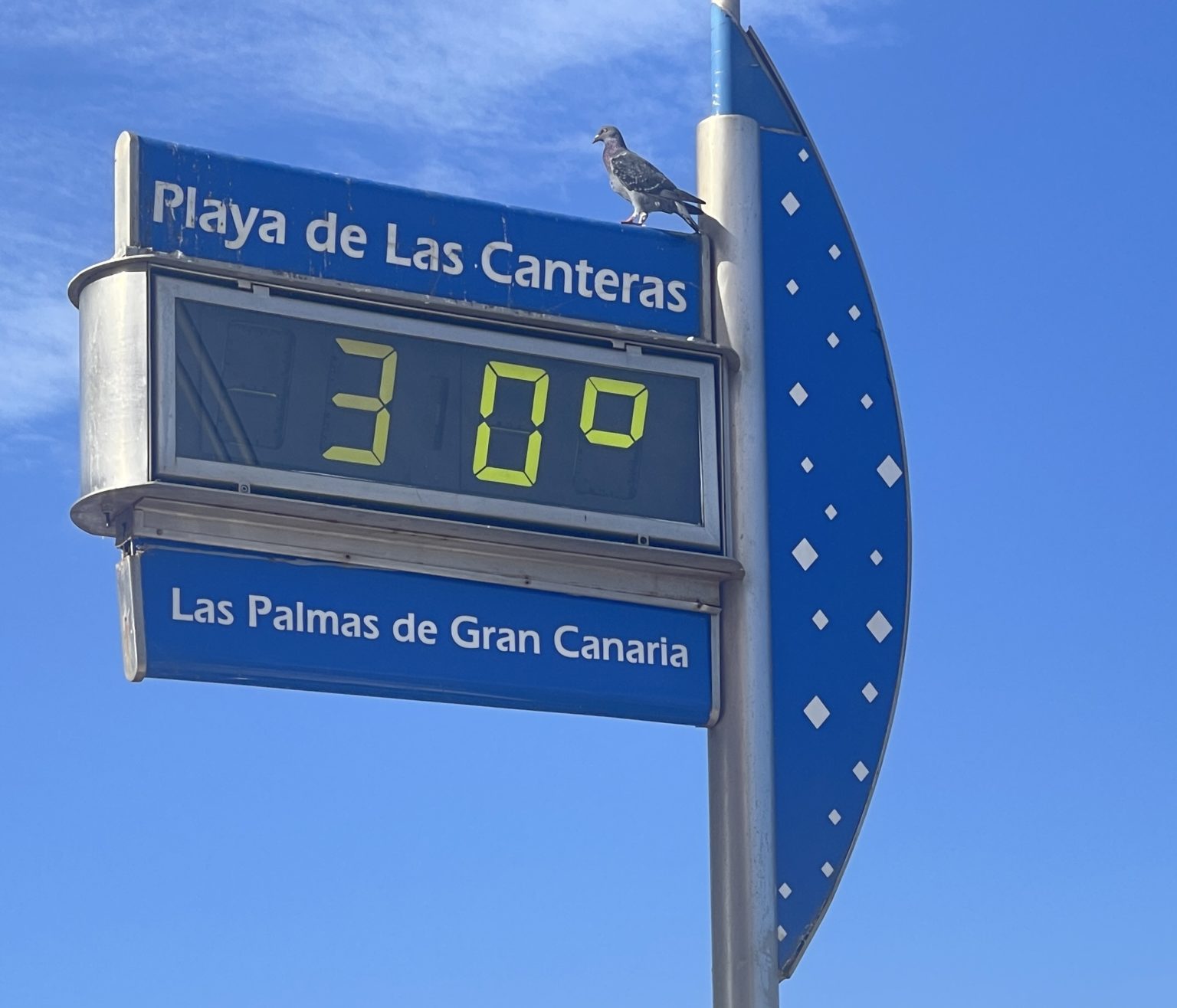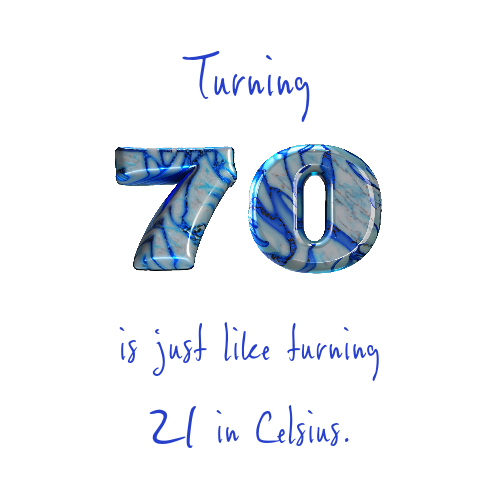We’ve been considering a brief trip back to Morocco this winter and that got me thinking about past travels we’ve enjoyed. Back in the day (before we got all hoity-toity with our own blog site) we would often keep our family and friends informed of our adventures with emails. So, it occurred to me that a few of you might enjoy accounts of our past adventures. Here’s a series of emails from November of 2015 – our first trip to Morocco. I’ve edited a bit and added photos. I hope you’ll enjoy it.
Email #1 November 24, 2015 – Day One
I write to you as we journey on the night train to Casablanca.
I had to say that . . . it just sounds so cool.
First, I hope that you are all well. As the weekend has turned to Thanksgiving week, our thoughts of family and friends have become more insistent. Our adventure through Morocco is becoming a mix of intriguing new stimulations accompanied by the occasional sting of absence from our loved ones. In other words, having a great time, wish you were here!
It’s hard to know where to start telling you about this trip. When we set out from SFO Thursday evening, we did not have much of an itinerary. We had some vague notion that our phones would be connected to Google, we’d talk it over on the plane, and things would work out. I know that doesn’t sound like our usual approach, but our activity level in the past several months really caught us off guard and we simply never got around to planning very much. We even forgot to bring along the guidebooks we had purchased many months ago, but never read. As we boarded the British Air flight to London for the first leg, we had a place reserved to sleep most nights in three different Moroccan cities. That’s pretty much it. In keeping with this haphazard approach, our British Airways flight was an hour late leaving SFO, causing us to miss our connection in London, and prompting Iberia (our booking airline) to reroute us on Royal Air through Casablanca to our final destination, Marrakesh. Unsurprisingly, our baggage lacked the necessary travel acumen to make this adjustment, and our first stop, after making our way through customs (disappointingly modest passport stamp), was the Royal Air “lost and found”.
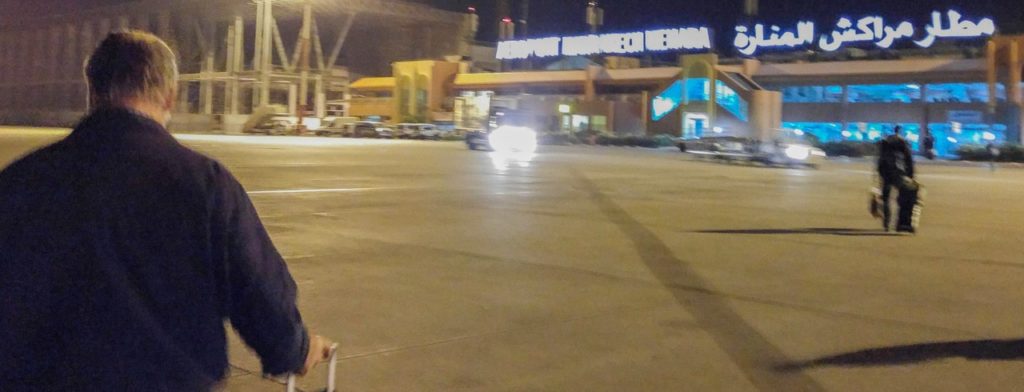
“No,” we were told, “we have no idea where your bags might be. Perhaps Madrid. Maybe London. There is another flight arriving in the morning. Perhaps they will show up then. Bon soire.” Fortunately, Bonnie and I have advanced to the level of modestly seasoned travelers. Having come to expect exactly this result, we had both packed enough essentials for the first two days in our carryon bags. So, we emerged from the airport at 1:30 in the morning Friday relatively unconcerned. Our host in Marrakesh had been informed of the delay, and would have a bed waiting, we would call the airport in the morning. The luggage thing would work out . . . or not. (Notice how carefree we are becoming in our dotage.)
The Medina
And so, we found a taxi and made our way through the silent, deserted streets, toward the ancient walled medina that contained our riad, a massive arched gate looming ahead. We passed through into twisting, trash strewn alleys of crumbling pavers, lined with seemingly abandoned buildings. My western sensibilities began kicking in about now. And, just as my imagination was conjuring the image of mujahedeen surrounding the cab, scimitars gleaming, our driver came to a stop in one of the darkest streets yet, and a figure, swathed from head to toe in a rich blue drapery, complete with turban, emerged from the dark. I fought the impulse to cry out a warning, and instead heard my name quietly spoken in a richly accented rumble. Apparently, we had arrived. The blue ghost led us down a narrow dark passage between buildings, unlocked a door and allowed us to step through into a candlelit oasis of beauty and grace unimaginable from the exterior.
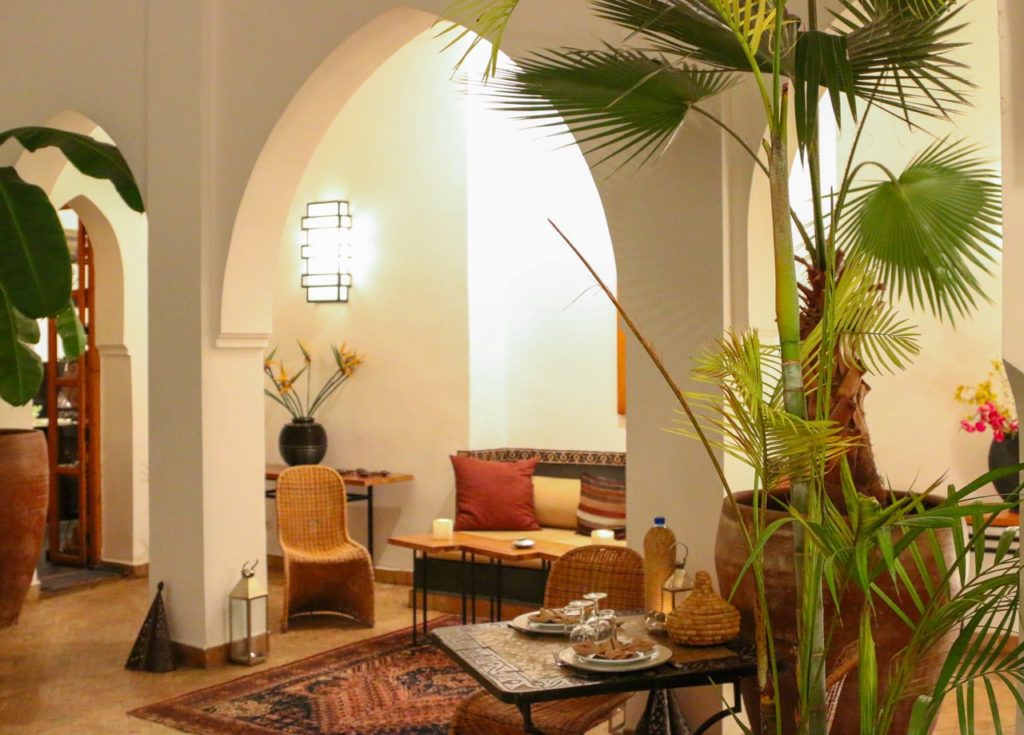
We were awakened the next morning by the sound of children’s laughter, followed shortly by the second call to prayer, and we turned to each other bemused by the strange Saturday that lay before us. Riad is the name given to a certain class of traditional home found in the heart of these ancient walled cities. Generally, they are gracious three-story homes created around an open, central courtyard. Trees and vines reach upward to the second and third levels, light streaming through the building’s open, columned architecture. Many of these centuries old structures have been repurposed from their initial use as the estates of successful merchant families into boutique hotels or guest homes. The other, inevitable feature of a riad is the rooftop patio and garden. It is to this area of Riad Miski that we were directed to our breakfast, overlooking the surrounding roof tops, with the High Atlas Mountains visible through the distant haze.
We lounged like cats for a while, soaking up the sun, working on developing full consciousness, recovering from the previous 36 hours. Emmanuel, our host came by around mid-morning and sat down with us to begin our education on the nuances, pleasures, and dangers of the medina. The Marrakesh medina, like others in the ancient world, is a fortified city defined by massively thick walls, where the traditional life and culture of its inhabitants has continued largely unchanged for centuries. By this, I don’t mean to imply that the modern world has not had an impact. The rooftops sprout satellite dishes like mushrooms in December around our beloved Villa Ondina, and cell phones are ubiquitous. The citizens of the medina, however, make their way through life subsisting on the basis of their craft or trade, utilizing almost nothing in the way of modern equipment or methods. Every conceivable nook and hovel are filled by an artisan or merchant engaged in the single-minded business of producing his livelihood.
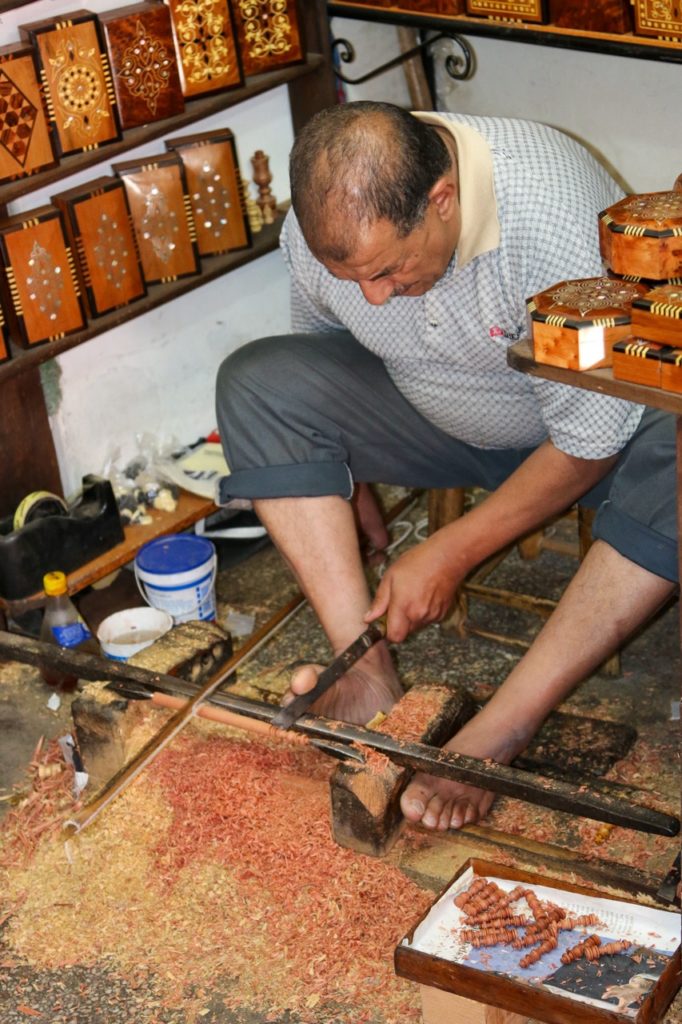
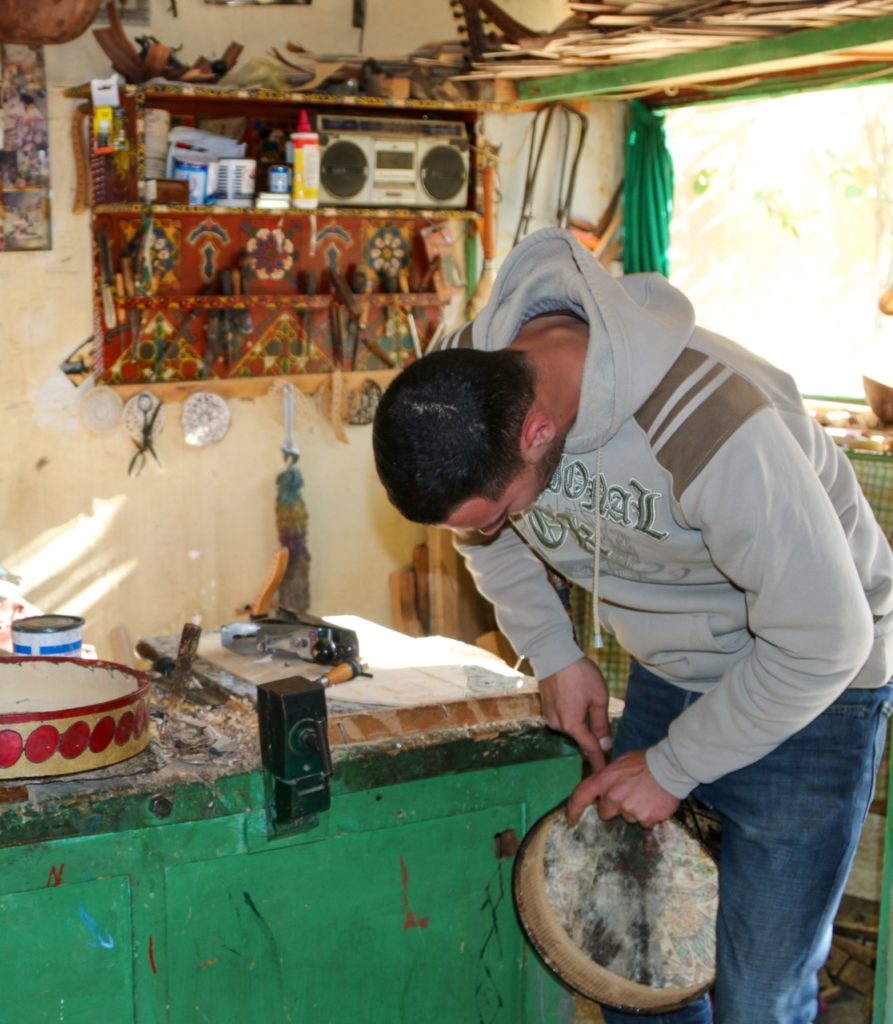
Instant Immersion
As we stepped from the tiny alleyway that connected Riad Miski to the rest of the medina, we entered a whorl of activity, color, smells, sounds, and stimulation that I despair of ever conveying to you. After walking only a few hundred meters, we turned to each other in amazement, both expressing the same thought. How are we ever going to tell them about this back home? By Saturday evening, when seemingly every resident of the city was in the streets, it became clear that photography would be useless. No photo, or book of photos, was capable of conveying this experience. Perhaps a video, handled skillfully could begin to hint at it, but nothing more than a hint. How to explain the cacophony of sensory inputs? Let me try this:
Imagine a New York sidewalk on Fifth Avenue at the height of the holiday season early on a Friday evening. Now, to the pedestrian traffic, add a continuous stream of bicycles sharing the same space, dodging and weaving. Are you with me, so far? Next, add to this imagined scene an equal number of motor-scooters, operated at the highest possible speed for the conditions of the moment, swerving and jostling with the bicycles, accelerating and braking with heart stopping agility, all in the midst of that Fifth Avenue pedestrian traffic. Now, if you’re still with me, (I am not making this up) toss in the occasional donkey pulling a cart laden with who knows what, the regular appearance of two wheeled hand carts, wheel barrows, and every other possible wheeled conveyance that might possibly be squeezed down a ten-foot-wide street lined on both sides with shops and stalls spilling out of the walls that form the tight lane. And, with this, I have only attempted to describe the movement, and clearly the danger, of merely being on the street. I cannot think how to explain the smells, sounds, colors, languages, costumes, curses, prayers, and the faces. Who knew human beings came in such variety? The act of simply walking the ½ mile to the central square involved a sensory overload unlike anything I have experienced . . . until the street opened onto the Jemaa-el-Fna Square.
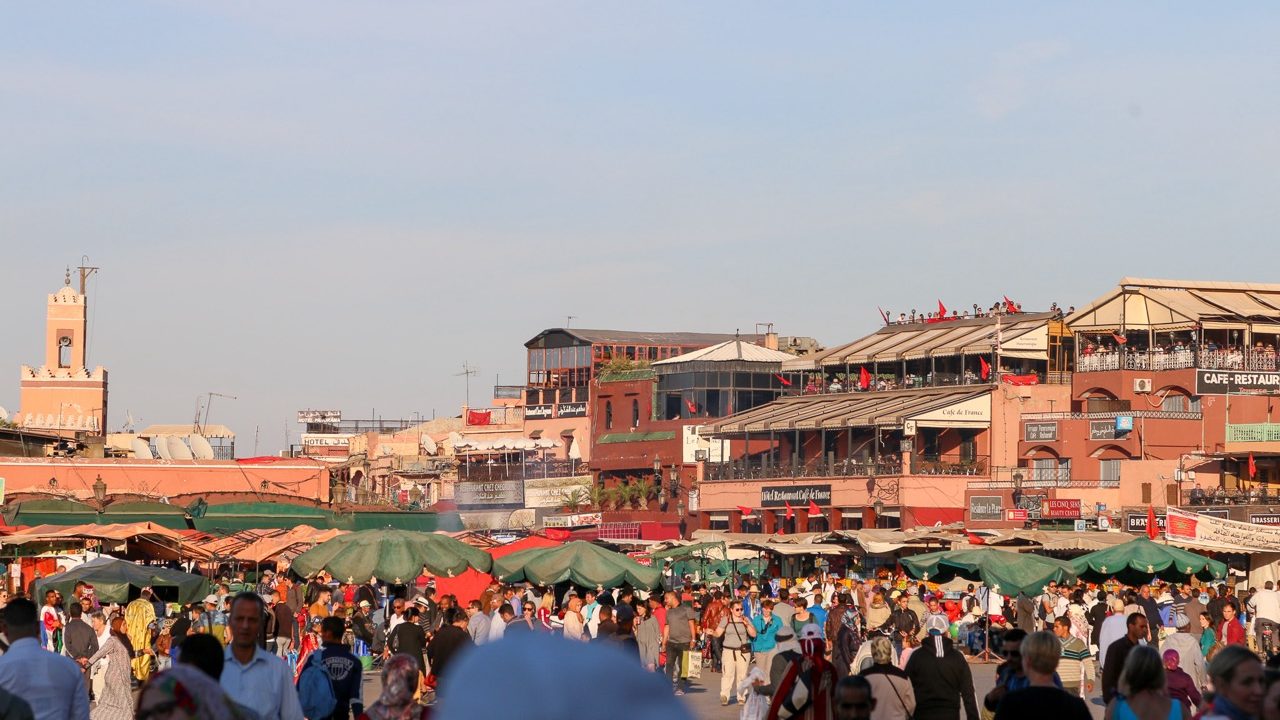
The square is symbolically and truly the center of life in the medina. Part community center, part tourist trap, throngs of natives and visitors cover this vast square, and as the day began drifting toward evening, an enormous carnival of food vendors and pop-up restaurants began to take shape amid the snake charmers, henna artists, monkey trainers, acrobats, and jugglers. The incessant honk of the snake charmer’s horn, the rhythmic pounding of drums, the cries of vendors hawking every conceivable manner of food and drink (alcohol and pork not in evidence), groups of musicians, and every other person shouting into their cell phone all combined to produce a non-stop din until the evening call to prayer provided a brief respite.
This first day, having braved the adventure of merely walking through the medina and enjoying a light lunch on the rooftop of a café on the square, we made our way to the Berber handcraft center where some of the finest craftsmen in the region are allowed to set up shop. Here, off the beaten path and away from the square we were able to quietly stroll through each craftsman’s shop without being harangued. Bonnie had to have a hand-drum and we selected a number of other possible purchases. Finally, we made the long trek back through the teeming streets to the riad, collapsing into the silent, tranquil, secure embrace of our temporary home and feeling for a moment, how precious these interiors must have been to their original owners. After a rest and a call to the airport, “no I am afraid we still have no idea where your luggage is, but there is a flight arriving at 10:00 am . . . ,” we screwed up our courage and headed back out to make our way to a restaurant reservation.
A teachable Moment . . .
Now, we experienced the full medina. At times the pedestrian traffic became congested to the point of forcing the motor bikes to walk with everyone else. It’s the first time in my life I have been grateful for a traffic jam! We promptly got lost. Posing as a helpful guide to the unsuspecting visitors is one of the principal games played by the touts in these streets. Having led the tourist on a wild goose chase through the twisting alleyways, the guide then demands a generous tip for having brought them safely to their destination, which they may have reached by simply continuing their original path. It was with some trepidation, then, that we accepted the guidance of an eager young man to guide us into the warren of souks toward Restaurant Nomad. After a long, winding route, we began to make a turn that would clearly begin taking us back in the direction we had started. Bonnie declared, and I had to agree, that we’d been had. We were strategizing how to extract ourselves from this situation when I spotted the restaurant’s sign not 50 feet from us! We gratefully provided our thanks, and a generous tip, and made our way to the patio bar on top of the restaurant. A bright moon, wonderfully interesting food, a gently cooling evening, and a slow stroll through the now abandoned streets to our waiting bed completed day one of our Moroccan adventure.
Email #2 – November 25, 2015 – Day 2
Note: Rereading the following account of day 2 was especially poignant for me in light of the magnitude 6.9 earthquake that struck the region in September of 2023, killing 3,000 and injuring many thousands more. The epicenter was in the Atlas Mountains where the Berber’s were particularly devastated.
The Atlas Mountains
After my narrative regarding Day One, I’m sure you are opening this message with some trepidation. “Surely, he’s not going to go on and on about every day of their trip?” No. Alas, everyday cannot be so stimulating. I do, however, feel an obligation to recount our Day Two adventure. After all, every good story needs a sequel, and sequels always come with lower expectations, which suits me in this instance.
Before leaving for dinner that first evening, I had asked our host if he might be able to arrange an excursion into the mountains for us on the following day. Jose, our Berber guide met us at Riad Miski around 9:00 AM, directed us to a late model mini-van, and introduced our driver, Mohammed. The day had dawned overcast and drizzly, forcing our breakfast off the roof terrace, but as we headed out of the city, the sky began to lighten, and our attitude could not be dampened. We were headed into the High Atlas Mountains that rise to the South and East of Marrakesh, forming a great barrier between the broad, fertile valley the city occupies, and the dunes of the Sahara Desert.
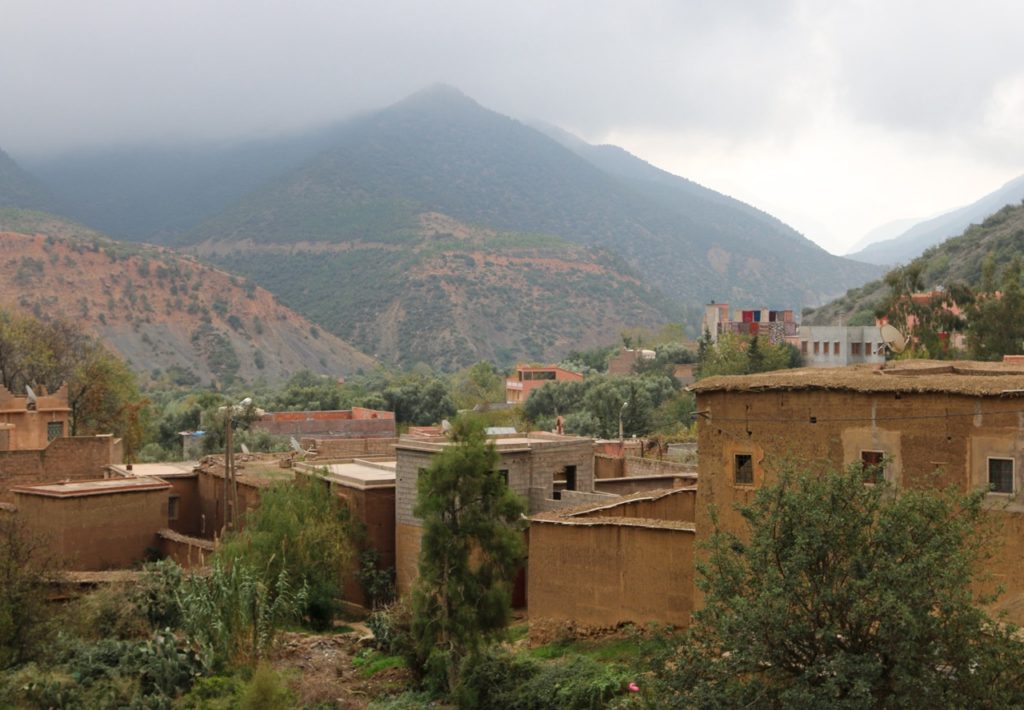
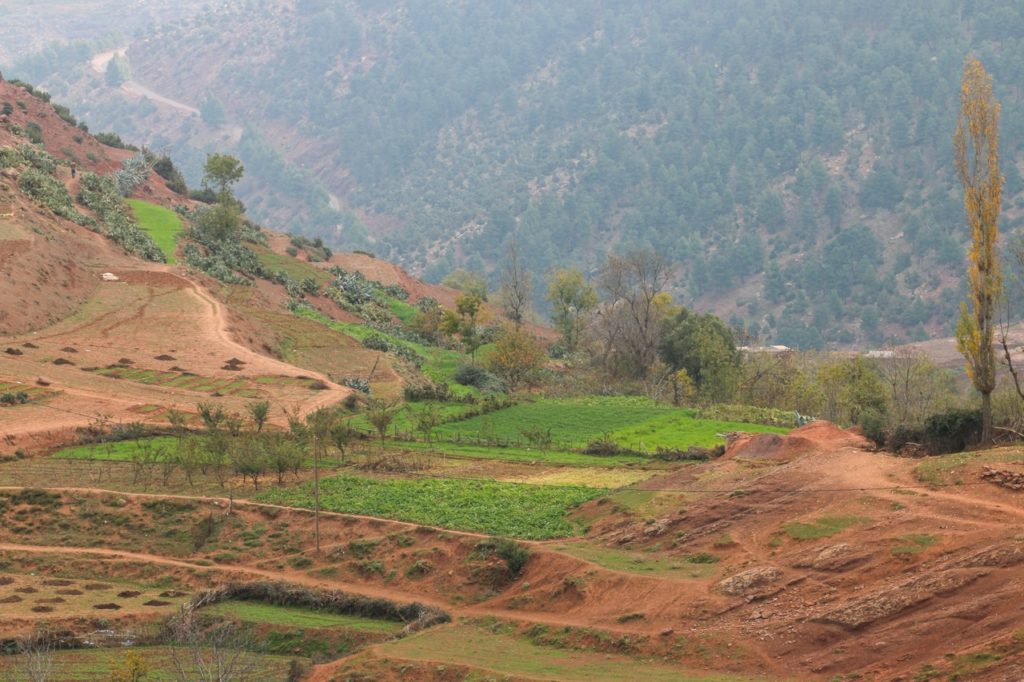
As we began our journey, Jose explained in very excited terms that we were incredibly fortunate to have him as our guide on this Sunday because it was Berber market day! We would be stopping to tour this excellent example of his people’s culture on our way to the mountains. This announcement had very little impact on us. After all, hadn’t we just spent a day in the Marrakesh market? As the scenery around us became more distinctly rural, our highway became a two-lane country road populated by motor scooters, bicycles and the occasional car. I was struck by the almost complete absence of trucks, vans, tractors, or any of the equipment we associate with agriculture in the West. Nonetheless, it was clear that we were traversing a rich farming area, with fruit and olive orchards stretching as far as we could see on both sides of the road.
Berber Pride and Angst
As we drove, Jose delivered a lecture on the recent changes in Morocco. As I am sure you recall, some four years-ago now, the Arab Spring erupted across North Africa, beginning in Tunisia with the toppling of the dictatorship, spreading into Egypt and Libya, and unsettling Algeria. Morocco was similarly affected, despite the general feeling that their King was a benevolent and generous ruler. As the unrest spread, the King moved to get ahead of history by convening the parliament, and offering to create a new constitution, shifting a substantial amount of power from the monarchy to the people. There is some debate over just how much authority the King actually relinquished, but there were other, very dramatic changes affecting Moroccan society that Jose was eager to recount for us.
“Morocco,” he announced with some pride, “created a new constitution three years ago. This has changed many things for us.” He went on to explain that among the key provisions of the new constitution was the absolute equality of all people under the law.
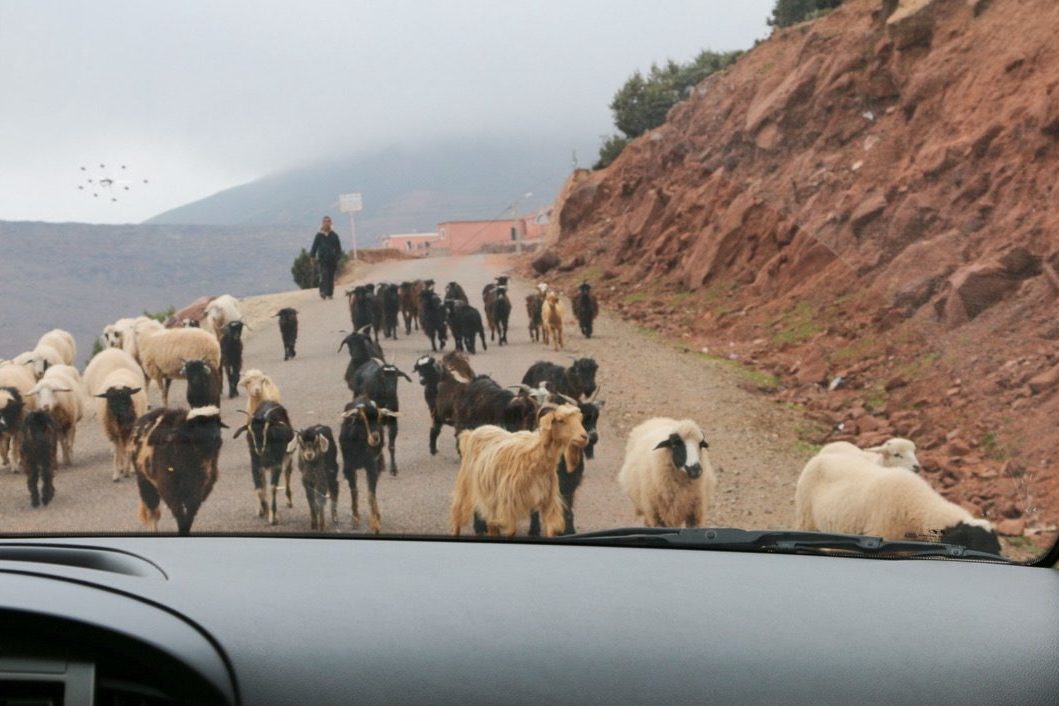
“Until now, the Arabs treated Berber people like slaves,” Jose stated flatly. “Now,” he explained, “we have all the same rights. Berber and Arabs, we live in parallel, now.”
Bonnie and I were aware that the Berbers were indigenous to Morocco and had lived under Arab rule for centuries. What we had not understood is that they represent more than 60% of Morocco’s population, and their language bears no relationship to Arabic. For the first time, the new constitution officially recognized the Berber language in both government and education settings.
Jose’s more startling pronouncement, however, involved equality for women. According to our guide, the new constitution provides full equality for women and mandates that all children, both boys and girls, attend public school to a minimum age of 14. The tradition among the Arabs of taking multiple wives is now conditioned on the written permission of all existing wives and includes strict financial obligations. If a man wants a divorce, he now faces the same prospects as a westerner – alimony, joint custody, etc. For a traditional Islamic country to adopt these positions constitutionally would seem to presage a cataclysmic culture shift which Bonnie and I see as essential for the future of our world. From our experience so far, however, it seems that it will take several generations for the reality to match the promise. As for Jose, he was very clear about what it meant.
“For us men, it is over,” he declared. “We are finished! The women work harder than the men and will now be educated like men. We are done. In a few years, women will run everything.”
We joked and teased about this the rest of the day. But, in the end I was never clear where his true feelings lay. I could not help feeling some empathy for his plight – on the one hand, he was thrilled by his new equal standing with Arabs, while at the same time apprehensive about the scope of the changes that were coming. We were so absorbed in our conversation with Jose that I failed to notice that we had entered a village until we slowed and stopped along the side of the road at a place that looked initially like the saddest flea market on the planet. We disembarked, and Jose, grinning broadly, led us into a Berber Sunday market.
Market Day
Our first stop, after picking our way through the mud, debris, stray cats, and general chaos was the abattoir. For the uninitiated, that is the meat market, or more correctly, the butcher shops. As we approached, Jose stopped abruptly with a slightly mischievous look in his eye, as if a thought had just come to him.
“You are okay?” he asked tentatively, “with seeing the meat, where is comes from?”
“I’m a nurse,” Bonnie retorted, a little miffed.
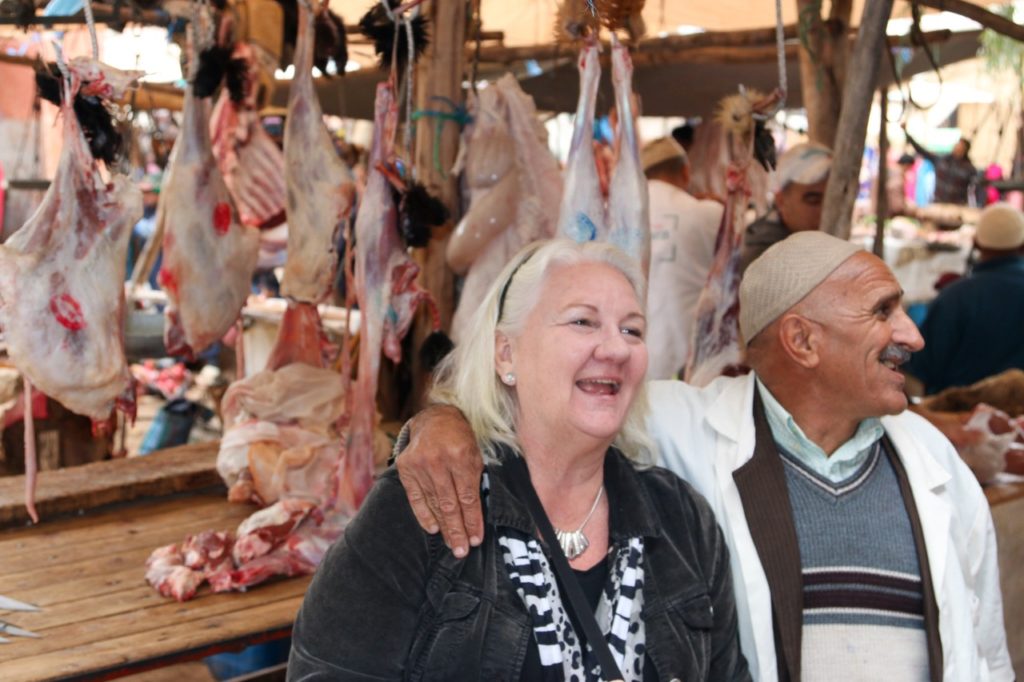
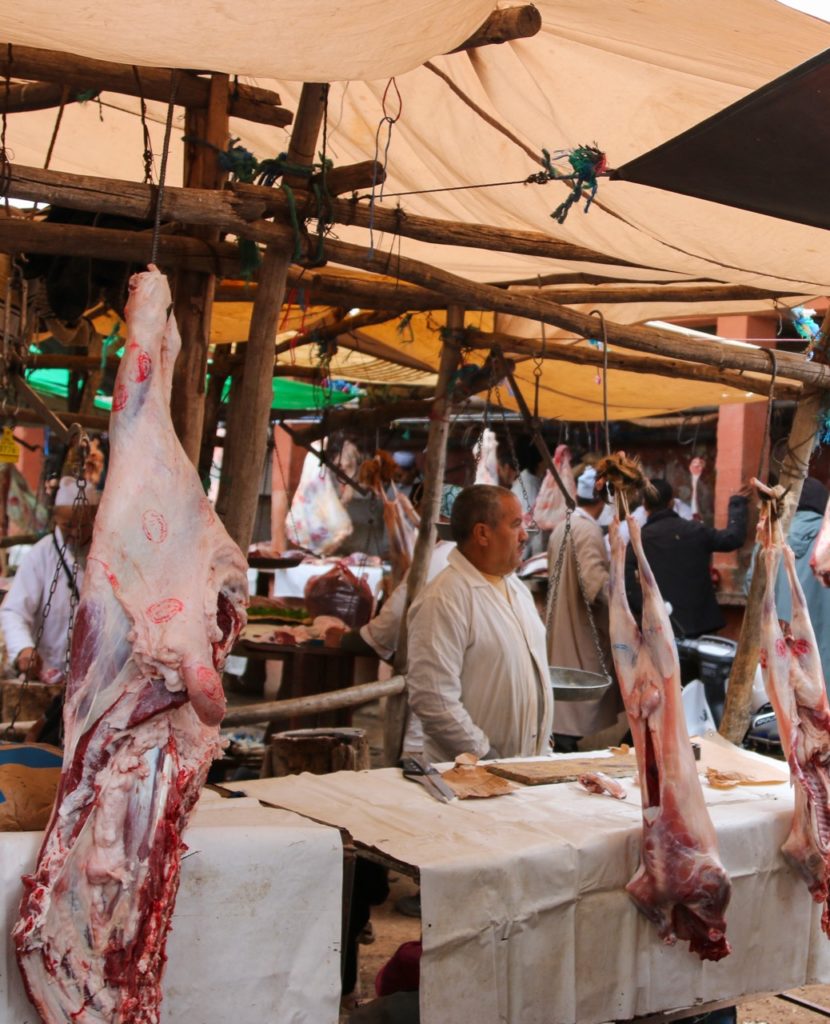
It seems we had missed the earlier events of the day, in which the animals are bartered, selected, sold, and slaughtered. By the time we arrived, the area was a forest of hanging carcasses in all shapes and sizes. With delight, Jose pointed out that today they had camel, apparently one of his true favorite sheesh kabob meats. The butcher featuring camel meat this day was quite easy to distinguish from the others. His was the stall proudly displaying the softly furred camel head hanging on a hook through its lower lip. The proprietors were delighted with the appearance of the Americans, competing to have pictures taken, eagerly offering their specialty – young lamb, organ meat, beef, goat, and fowl of various descriptions, including peacock.
We proceeded through the rest of the market which represented the collective abundance of the region’s produce and livestock. We strolled past huge piles of gorgeous vegetables the equal of anything we might have found at the San Francisco Ferry Building on a Saturday morning, tables loaded with dried fruits glistening with sugar, the deep color saturation of sculpted spice mounds, alongside the vessels, tagines, and tools to convert this bounty into the richly spiced food we would be enjoying throughout the trip.
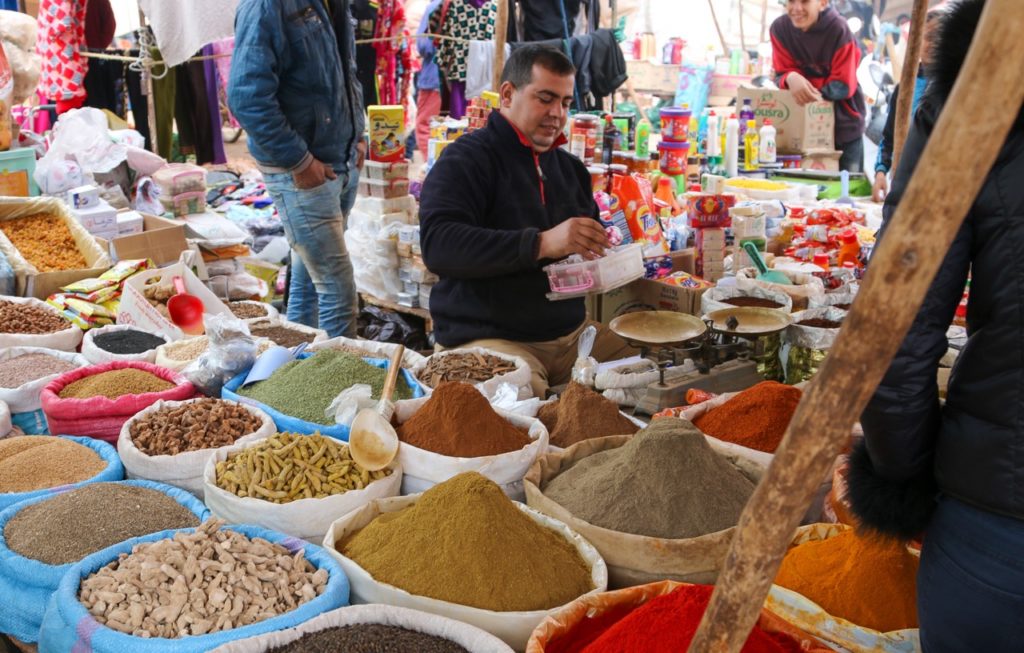
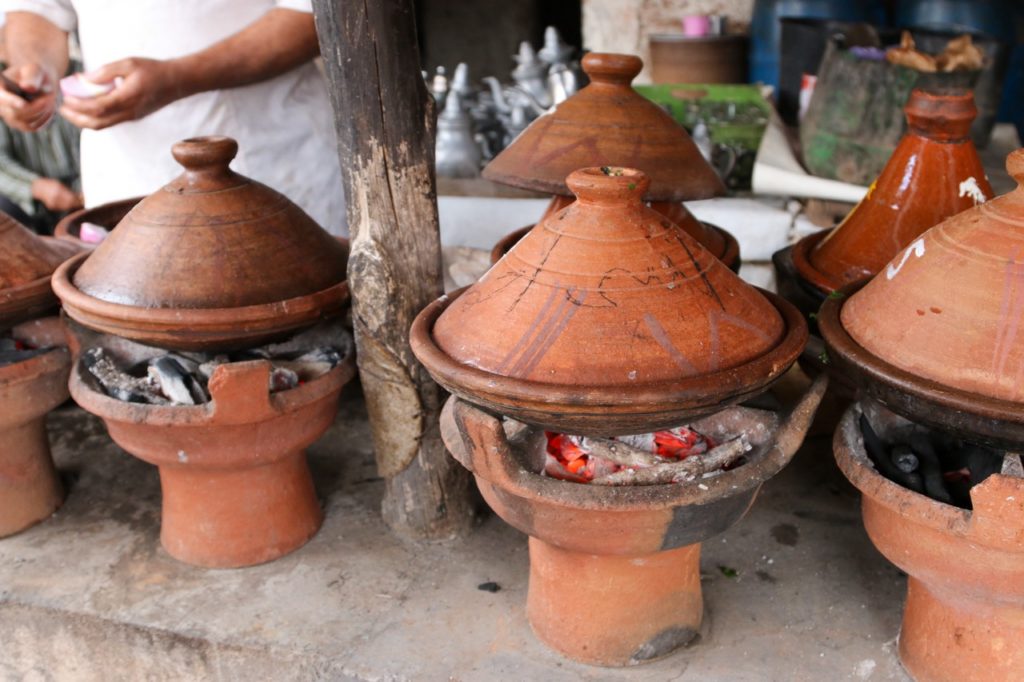
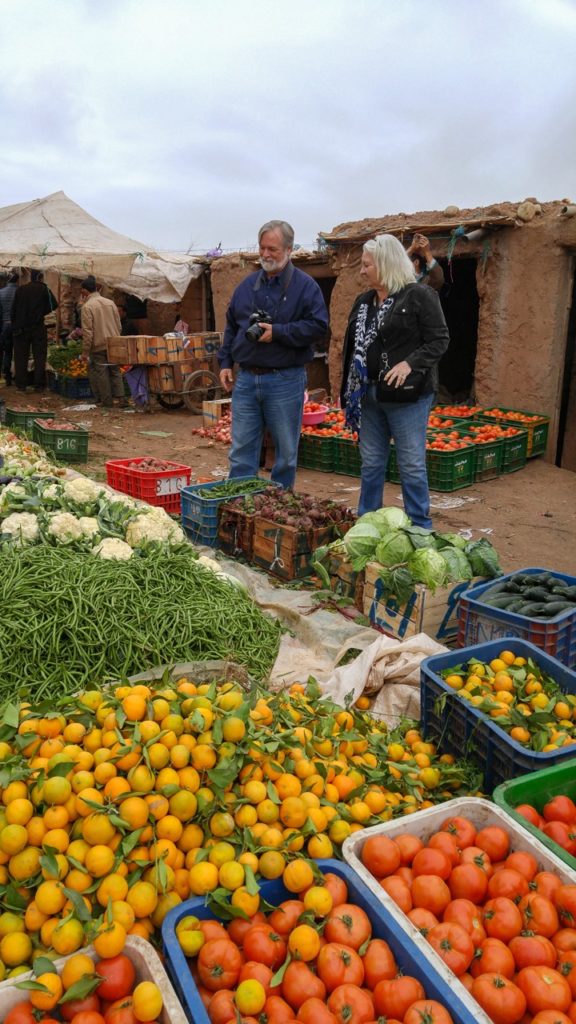
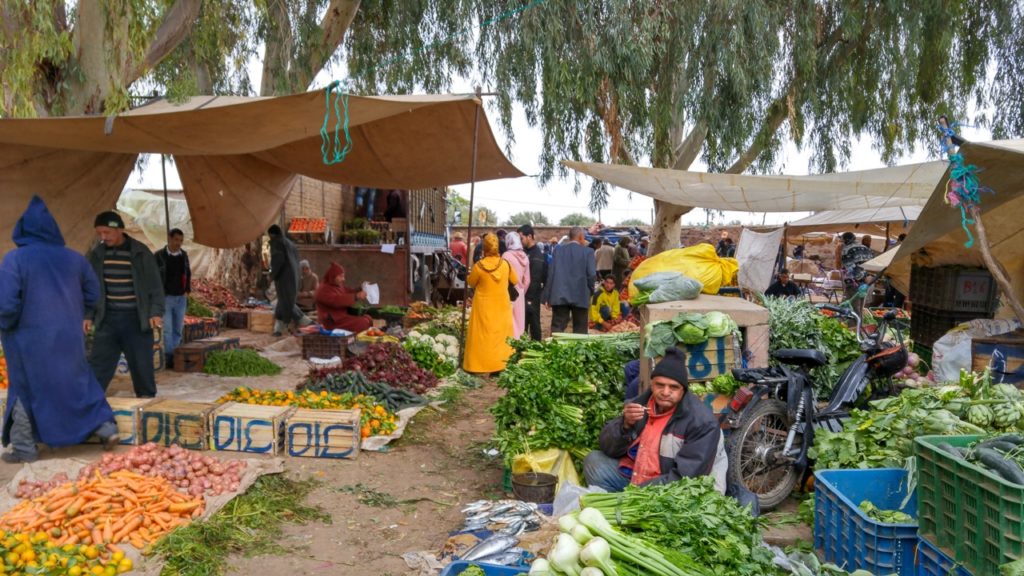
We returned to the van with a new sense of the Berbers as a community – generous, sharing, welcoming, and self-sufficient. By our standards, they live in abject poverty. However, when we asked Jose about the young people – if they had ambitions for a different life – he patiently explained that they loved their homes in the mountains, and almost all stayed to work within their village. The rest of our day was spent driving the single lane road into the cloud shrouded High Atlas, trekking across a mountainside to a small village, sitting on thick, hand woven carpets, our feet and legs ensconced in heavy wool blankets, as we watched mint tea prepared in the formal Berber fashion, and eating a lunch we were served from a steaming tagine of aromatic vegetables, spices, and chicken.
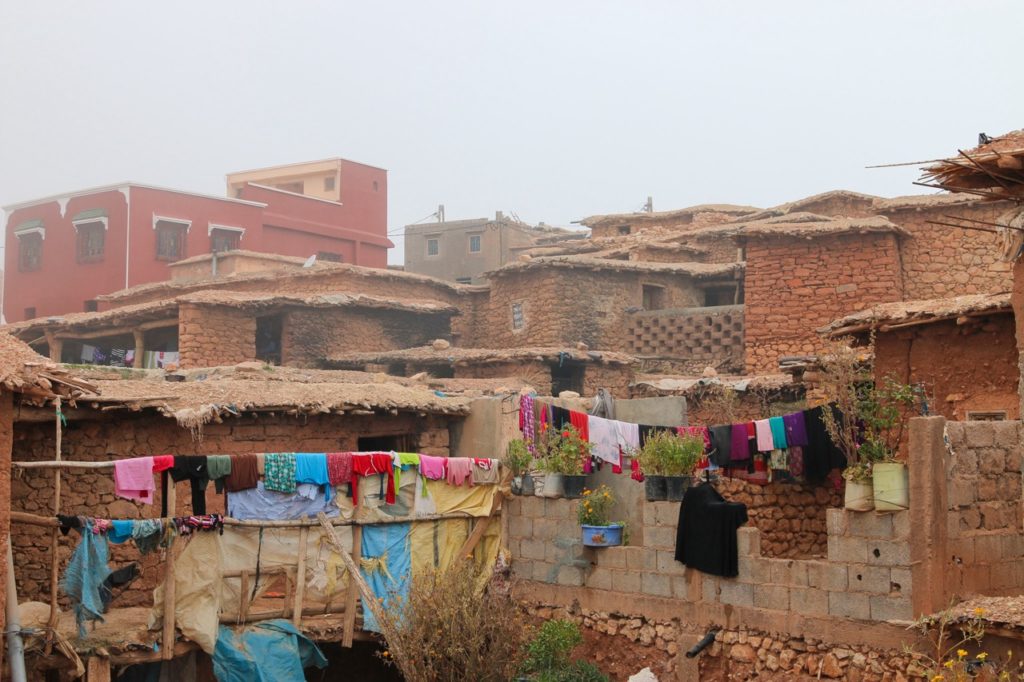
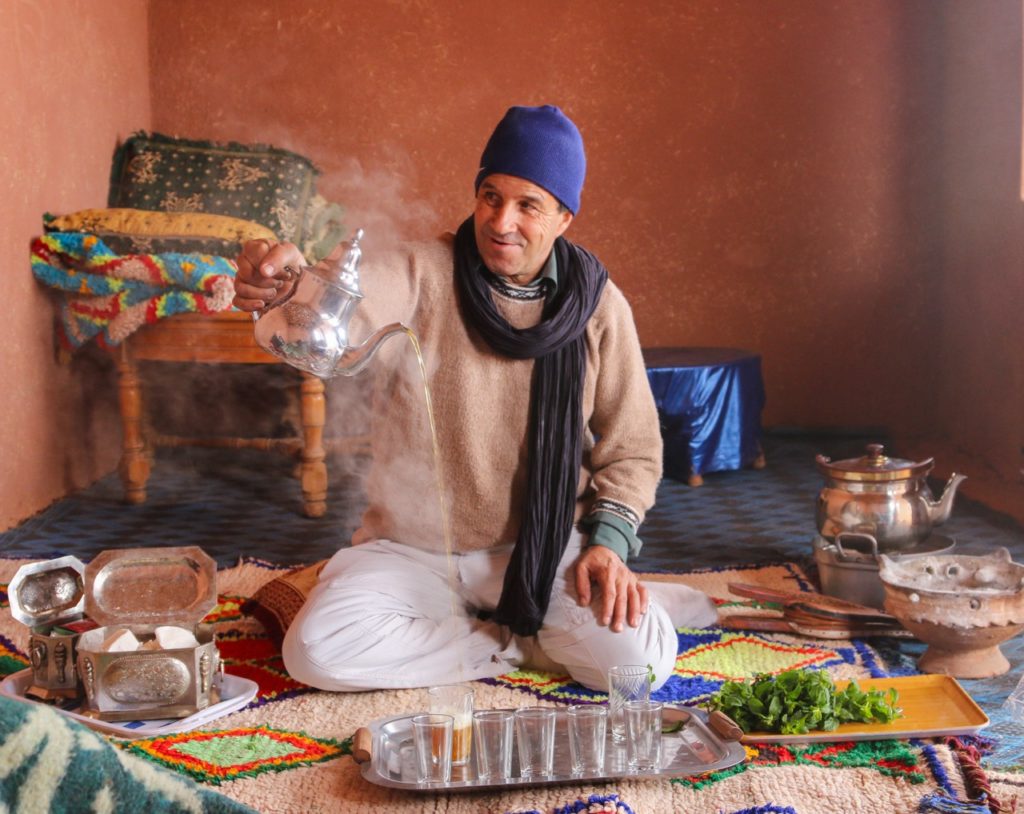
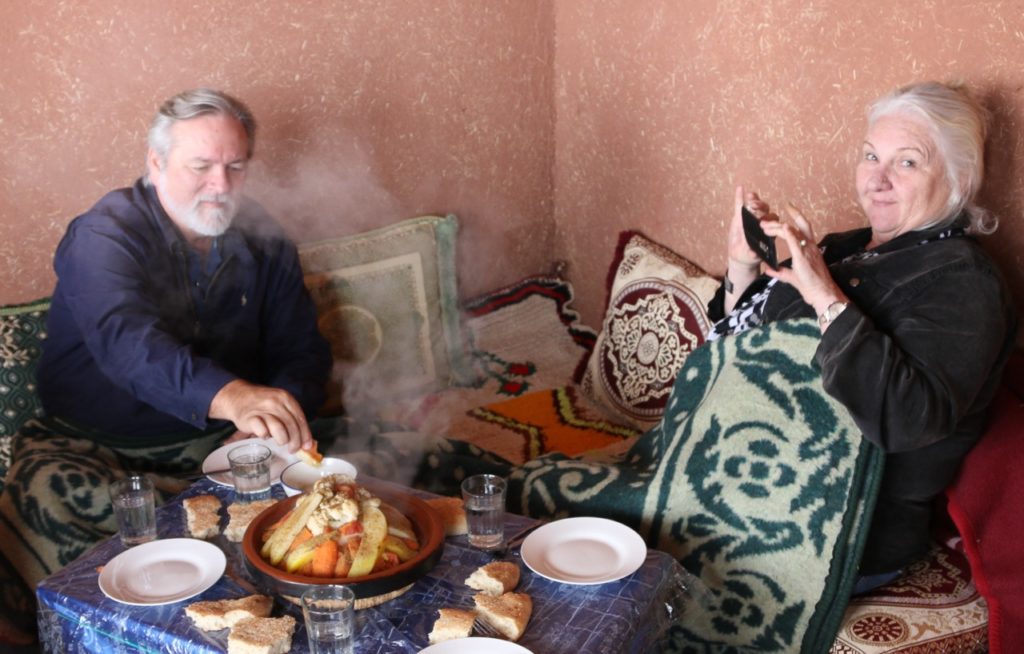

Warmed by the amazing hospitality of our Berber hosts, we slowly wound our way back through the high mountain valleys, each village clinging to the steeply terraced slopes, studded with apple trees, vegetable plots, pasture, and grain fields. Each curve revealed another small herd of sheep, a single cow tended by a woman and her children, a brook or stream tumbling through a burnt-orange clay gash in the lush green of the hillside. These quiet, peaceful, generous people live as close to nature as anyone we have ever encountered. It’s a raw, challenging landscape where the Berbers have scratched out a subsistence for uncounted generations. The village we visited for lunch had received electricity just four years ago, but most of the accoutrements – home appliances and the like – had yet to make an appearance. Nor, did they seem to be missed.
We arrived back in our riad as the sun was setting, tired, thoughtful, and contented that we had spent our day well. We had arranged to have dinner at the riad this evening. Our table awaited us in a corner of the courtyard, candles lit, a bottle of wine opened, just the two of us, served by our blue ghost in what may have been the most romantic dinner I have ever enjoyed with my wife of 42 years.
Email #3 – November 28 – Days 3 to 7
Well, our adventures in Morocco have hit a few bumps. Bonnie has acquired a head cold, and I managed to find an intestinal bug that has thoroughly drained me, if you’ll pardon the pun. The past several days we have been significantly slowed down. I am writing, once again, from a train. This time, we are headed back to Marrakesh from Fez where we will entrust the airline industry with our luggage (slow learners) and begin the trek back to California. With both of us being ill the past couple of days, we are ready to go home. Morocco has been a wonderful host. Its people are warm and generous. But this is Africa, and a third world country in every sense. It’s physically challenging, and we are feeling our age a bit. I will just briefly recap our week.
We continued to hang around the medina in Marrakesh on Monday, exploring deeper into the souks, and seeking out a few specialty areas – the wool market, and the felting shops, for example. Monday proved to be somewhat saner than the weekend, but still pretty hectic. In the late afternoon, we gathered our bags and said goodbye to Riad Miski, and took a taxi, first to the airport to pick up our final piece of lost luggage, and then on to the train station – destination Casablanca.
Rick’s Place
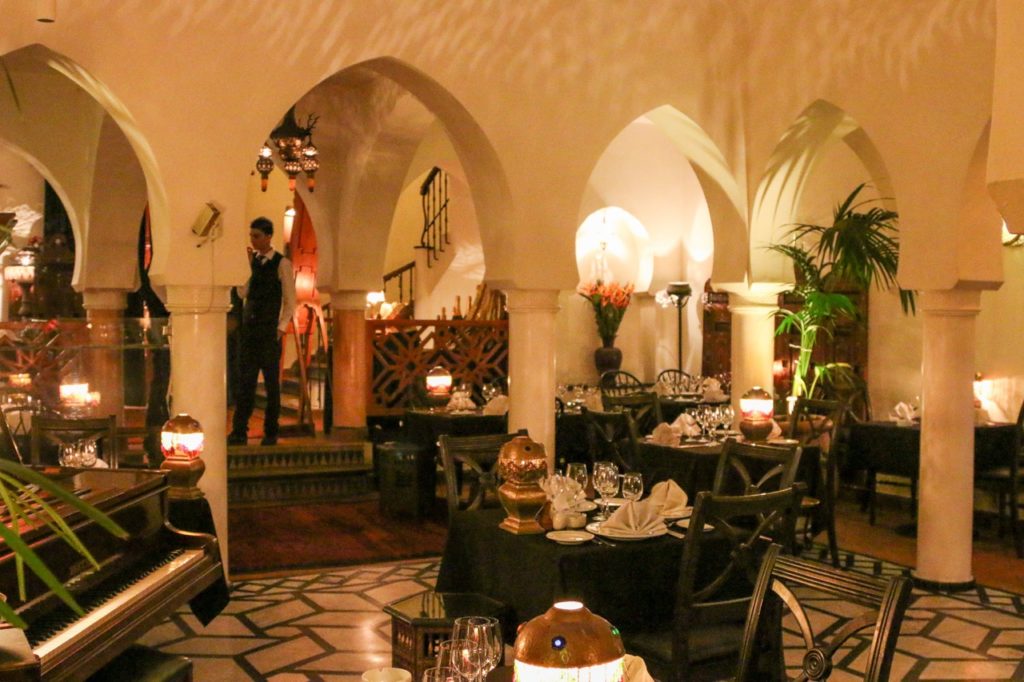
The best thing about Casablanca was the Hyatt Regency where we were treated to a spacious luxury suite with every conceivable amenity. After three nights in the medina, we both gave a sigh as the door swung open on that room, and the porter arranged our now complete assemblage of bags. As romantic as it sounds, it turns out there is not too much for us tourists in this busy port city on the Atlantic. There is, of course, Rick’s Café which we dutifully made our way to on our second night in town. As you probably know, the original Rick’s Cafe’ was on a soundstage in Hollywood. This one in Casablanca was actually created in the early sixties by some crazy American who was sure that the world needed the “real thing”, and it has become an institution of sorts – Morocco’s little piece of Disney-like fantasy.

About the only thing worth seeing is the Hassan II Mosque, said to be the second (or third – depending on your source) largest mosque in the world. This behemoth piece of architecture sits rather gracelessly on a mount that juts slightly out toward the sea, protected from the Atlantic’s pounding by massive sea walls. It’s a fairly contemporary structure, built in the late 20th century by the Sultan whose name it bears, and boasts the tallest minaret in the Muslim world. I’ll leave aside speculating about the Sultan’s need for this enormous construction. The whole affair was framed, as if composed for the purpose, in the view from our 9th floor room. The “Big Mosque”, as the locals call it, does display some wonderful craftsmanship, but in all, I found it to be relatively artless. Perhaps, after our trip to Istanbul, all other mosques will seem crude. But, of course, size matters . . .
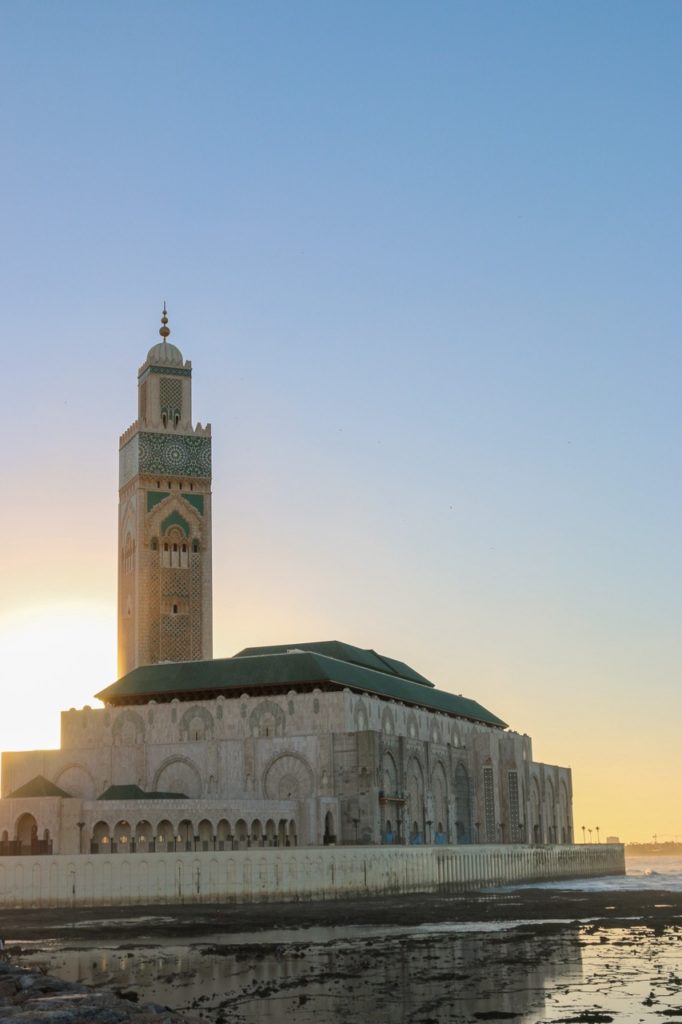

We were back on the train around noon Wednesday, headed for Fez and Riad Idrissy where we had booked three nights. All these hours of touring by train have really underscored the agricultural nature of Morocco. This is fertile farmland in a wonderfully temperate climate. Several times Bonnie and I have commented on how much it sometimes feels like California in that way.
The Labyrinth
We were met at the Fez train station by a driver who delivered us to one of the gates, or babs, in the medina wall. Here we were met by an escort, with a balloon-tired pushcart for our luggage, who would guide us to the riad. You see, there are no motorized vehicles allowed into the old city at all. Once inside the walls, the only mode of transportation is your feet. Our riad was a 15-minute walk from the closest bab over cobble stone lanes that suddenly made the streets in the Marrakesh medina seem like broad boulevards laid out in orderly fashion. The Fez medina contains well over 9,000 lanes and alleyways in a confused maze that only a native of the city can possibly navigate. Robert, our English host, has lived in the Fez medina for five years, and acknowledged that he regularly gets lost. Adding to the fun, Fez is built on a hillside, meaning, that these alleyways are rarely level – very often steep enough to require steps and stairs.
Riad Iddrissy was a family home built some 300 – 350 years ago, and displays the typical ornate carvings, intricate tile work, and ornamental plaster that any successful, self-respecting merchant of the 17th century would be compelled to cover the interior of his home with to demonstrate his wealth and success. In addition to the riad, the owners acquired the abandoned property adjacent to the house which contained the collapsed ruins of another home and had become the local trash dump. Here, after clearing the site (it took six burrows, six months) they created a very informal garden restaurant, punched openings into the riad, and assembled an altogether charming, full-service hotel. The bad news is that this is a four-story building and let’s just say that 17th century building codes relative to stairs were different from our modern expectations. In addition to the 12” rise, no two treads are the same. As Robert said, “They’re built as if each one was the mason’s first ever.”
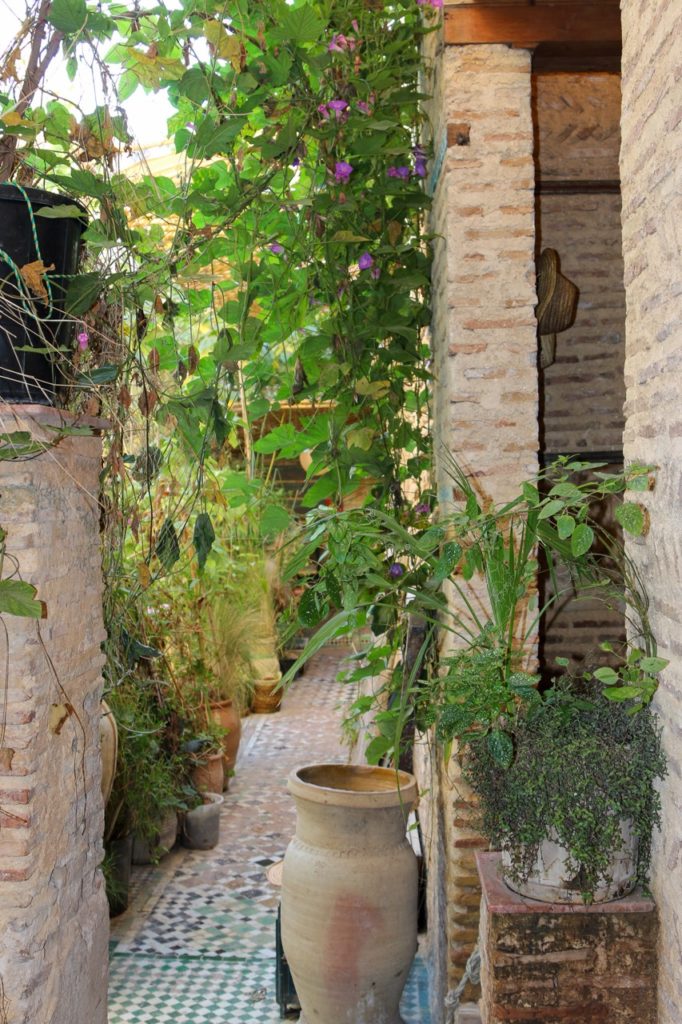
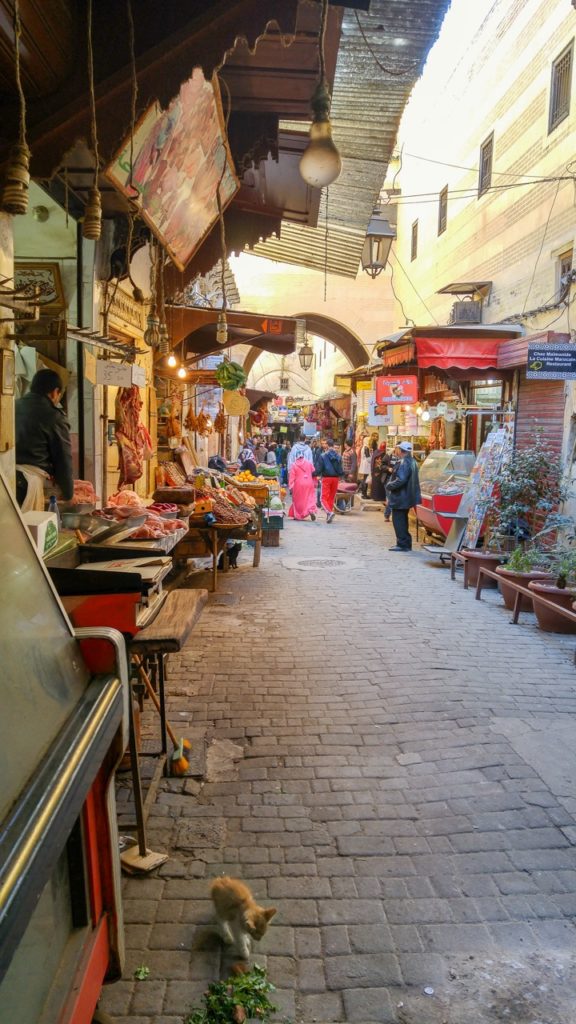
Thursday we were met mid-morning at the Riad by Yunis, our guide for the day who led us through many of the cultural highlights of Fez, including a stop at the oldest continuously operating university, founded in the 8th century. (I haven’t verified that claim about being the oldest, but given what was going on in Europe in the 8th century, I doubt there was any competition coming from there.) It was at that time, it seems that a particularly learned and progressive sultan came to Fez with the goal of turning the city into the cultural and intellectual heart of Morocco, and Islam. And, for a thousand years, that is what it became. Sultans and dynasties came and went, but the intellectual energy created by the establishment of that first university sustained Fez for centuries, up until the colonial era when Europeans began to dominate and exploit the culture.
Our education continues
Yunis, it turns out, is in the process of completing a dissertation for his PhD in Arabic literature. He completed two years of graduate work on a full scholarship at UCLA, where he has a standing offer to return and teach – an offer he is unlikely ever to accept because of his devotion to his heritage, and to Fez. Our day with him was a crash course on Islamic culture and life in the medina that we will long treasure. He was equally eloquent and informed whether the subject was terrorism or the question of why there were cats everywhere. As we strolled, he brought the medina to life for us, changing the inhabitants from costumed backdrop to vital, striving people whose daily concerns and responses to life were reflected in a hundred details around us for which we had no eye.
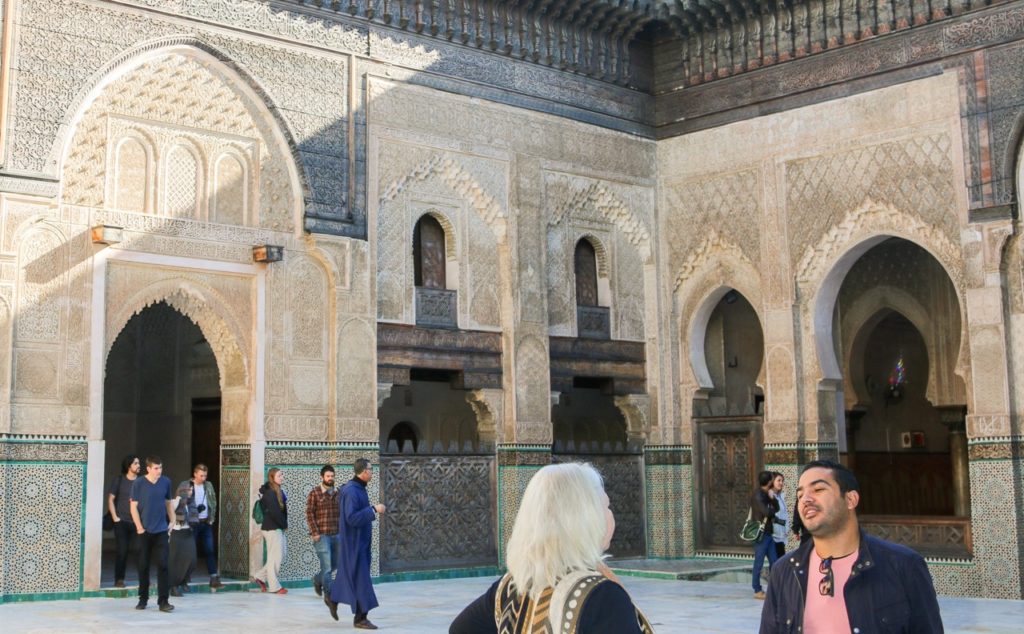
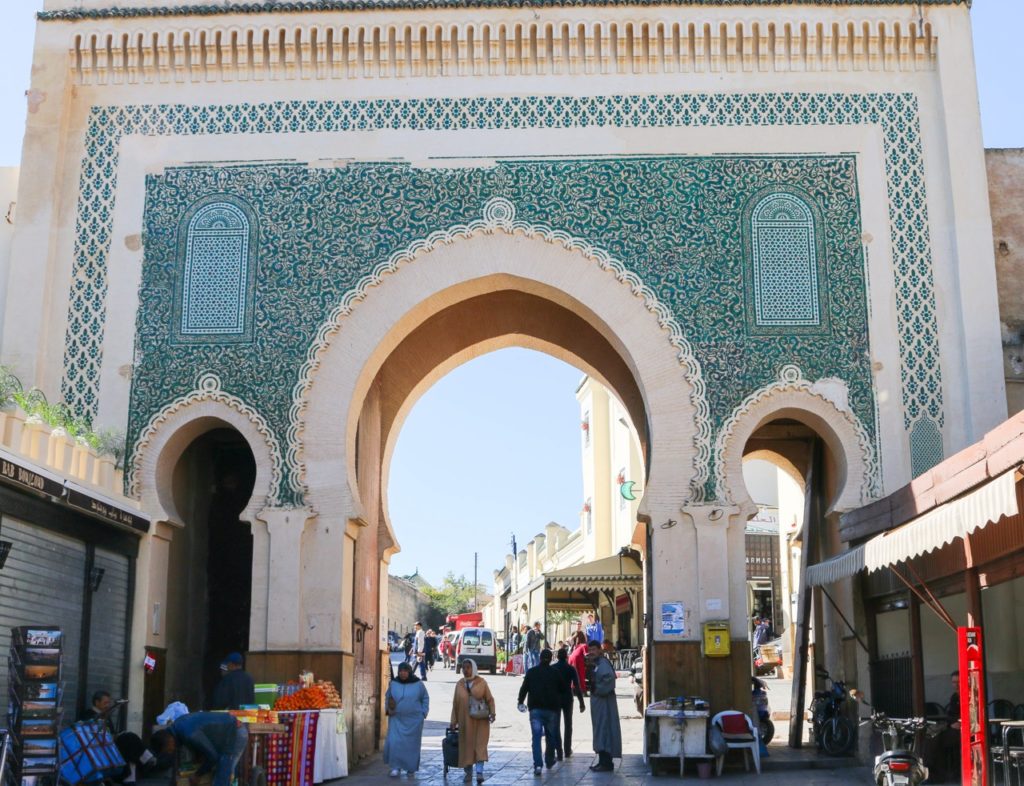
Another highlight of the day, for me at least, was a visit to the tannery section of the city. The tanneries date from the 9th century and have been in continuous operation since. Normally, I am told, the stench of the open tanning vats is nearly unbearable. However, on this occasion there was no smell and, alas, no leather. That’s because as part of the UNESCO World Heritage designation that has been given to the Fez medina, they are restoring the tannery. But this is no decades long, painstaking restoration by archaeologists. These people depend on the tannery as a job producing, economic engine. They need it back in working order, UNESCO or no. So, what you see today when you visit the tanneries is a work site with more than 150 workmen going at it 24 hours a day to rebuild and restore every element to its original working condition by the end of the year. I was suddenly on a job site, again! It was glorious. I have pictures.
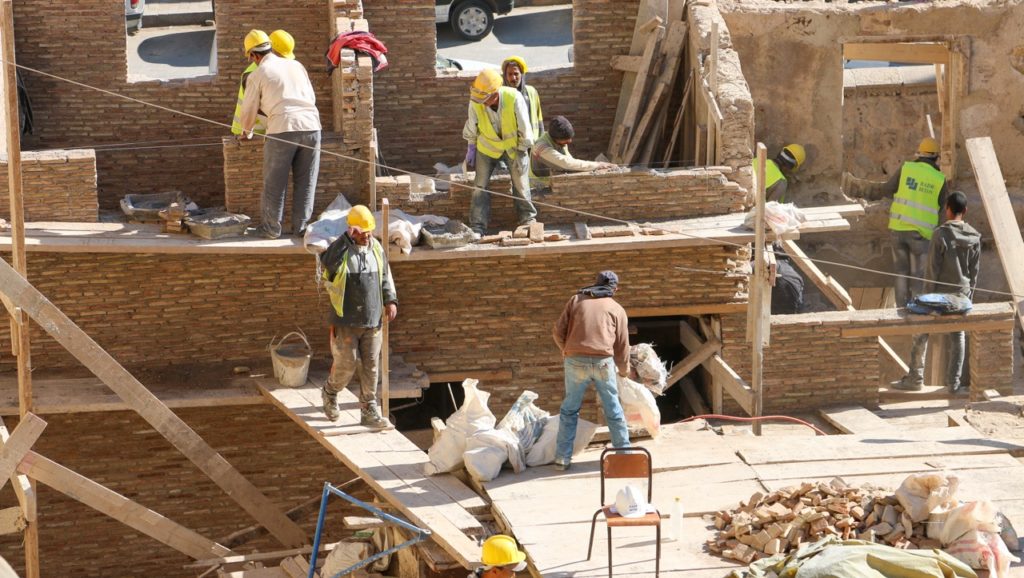
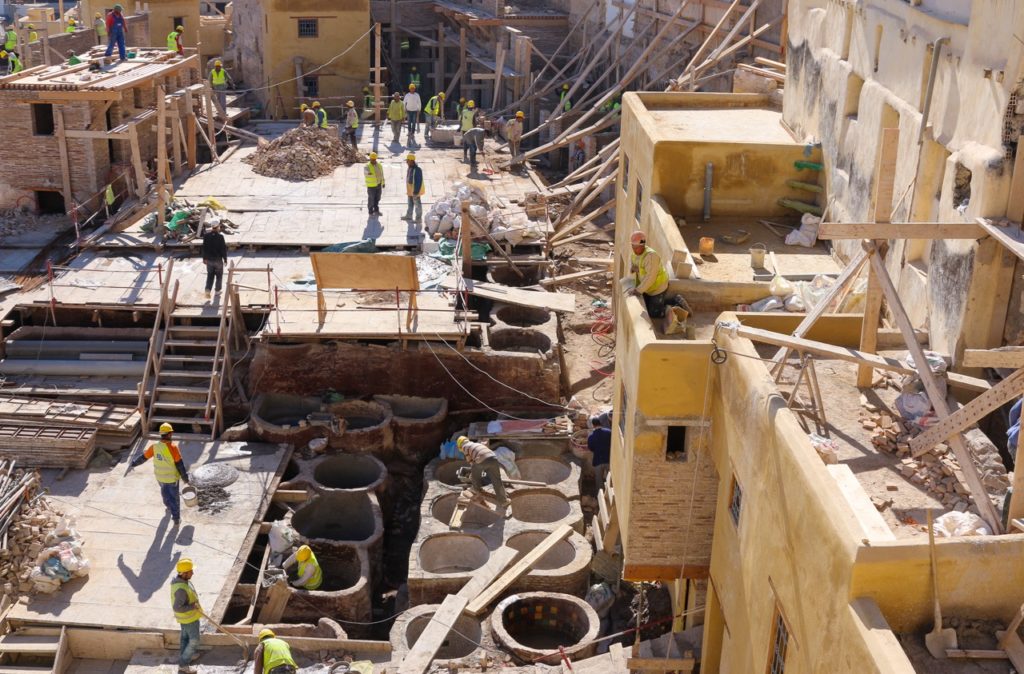
Friday, I couldn’t make the bell when it was time for our Moroccan cooking class. We spent the day resting and feeling sorry for ourselves. In the evening, we snuggled into bed and shared an iPad viewing of “Casablanca” in which it became clear to me that Rick’s Cafe was not even close to the “real thing.”
We are treating ourselves to the Marrakesh Four Seasons, tonight, and if we are recovered enough, one last night out in the Kasbah.
All our love,
Ed and Bon
About Us
Welcome to our little corner of the world where we invite you to embark on exciting journeys with us!
We’re Ed and Bonnie, a duo passionate about exploring the world and experiencing its wonders. Our love for travel isn’t just about discovering new places; it’s about sharing those moments with cherished family and friends like you.
Our hope is that you will feel like you’re right there with us, sharing in the excitement and wonder of each destination. Better yet, let’s plan a rendezvous somewhere wonderful! Learn more


